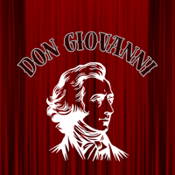
Overview
Synopsis
The famous tale of Don Giovanni centers around the womanizing libertine and his conquests. Don Giovanni sneaks into Il Commendatore’s house, with his side kick, Leporello, standing guard and attempts to rape or seduce his daughter, Donna Anna. Upon fleeing, after Donna Anna screams, Don Giovanni duels with Il Commendatore and kills him, before escaping with Leporello. Devastated, Donna Anna and her betrothed, Don Ottavio vow to discover who killed her father and bring them to justice. Giovanni continues to seduce every women he sees, including a former lover who is on the warpath to bring him to justice for her betrayal, and a peasant girl, Zerlina, on the eve of her wedding to Masetto, until they all band together to bring Don Giovanni to justice.
Escaping by throwing Leporello into the array in his place, Leporello threatens to leave Don Giovanni’s side. As Don Giovanni gloats at his escape, the voice of the statue at Il Commendatore’s grave speaks saying “Here am I waiting for revenge against the scoundrel who killed me.” Don Giovanni, unafraid, invites the statue to dinner, laughing off the encounter. Later, during a luxurious meal, ominous knocks are heard at the door. Leporello is frightened and hides, but Giovanni opens the door to find the statue of Il Commendatore. Giovanni is shocked, and refuses his entry, but Il Commendatore demands that he repent for his many sins. Giovanni continues to refuse until the statue disappears and demons come to drag Don Giovanni down to hell. The rest of the cast rejoices and states the moral of the story: “Such is the end of the evildoer: the death of a sinner always reflects his life.”
Show Information
Context
Wolfgang Amadeus Mozart’s Don Giovanni (1787) occupies a central place in the operatic canon as both a comedic and profoundly serious work. Based on the legendary character of Don Juan, the opera presents a man of insatiable appetite who lives by seducing women and defying authority, only to face ultimate retribution. The libretto, by Lorenzo Da Ponte, cleverly weaves together dark drama, supernatural elements, and sparkling comedy, creating a piece that has been classified as a dramma
to read the context for Don Giovanni and to unlock other amazing theatre resources!Plot
Act One
Leporello stands guard as he waits for his master, Don Giovanni, and complains about his life as a servant (Notte e giorno faticar). He is the lookout as Don Giovanni sneaks into the Commendatore’s house to attempt to seduce his daughter, Donna Anna, in disguise. Don Giovanni enters, being followed by Donna Anna, who insists that he unmask himself, and eventually screams for help. The Commendatore enters and forces Giovanni into a duel, for the honor of his daughter. Don Giovanni
to read the plot for Don Giovanni and to unlock other amazing theatre resources!Characters
| Name | Part Size | Gender | Vocal Part |
|---|---|---|---|
|
Lead |
Male |
Baritone, Bass |
|
|
Lead |
Female |
Soprano |
|
|
Supporting |
Male |
Tenor |
|
|
Supporting |
Male |
Bass, Baritone |
|
|
Supporting |
Female |
Soprano |
|
|
Featured |
Male |
Bass |
|
|
Featured |
Male |
Bass |
|
|
Featured |
Female |
Soprano |
|
|
Ensemble |
Either Gender |
|
Songs
Act I
Act II
A song with an asterisk (*) before the title indicates a dance number.
Monologues
Scenes
Key Terms
An aria is a solo vocal piece in an opera or oratorio that showcases the singer’s range and emotional expression. It is typically performed with orchestral accompaniment and often marks a moment of reflection or emotional climax.
An Italian theatrical form featuring masked stock characters, improvisation, and physical comedy, influential in modern comedy and clowning.
A genre that combines elements of humor and morbidity, exploring serious themes through satire or irony.
A deus ex machina (Latin for “god from the machine”) is a dramatic device where an unsolvable problem in a story is suddenly resolved by an unexpected, often supernatural, intervention. The term comes from ancient Greek theatre, where a god was physically lowered onto the stage by a crane (machina) to provide a solution or restore order. Today, it is often used to describe plot resolutions that feel abrupt or rely on forces outside the story’s established logic.
An opera genre blending serious and comic elements, commonly used by Mozart and other classical composers.
A German vocal classification system used in opera to categorize voice types and suitable roles.
The complete text of an opera, musical, or other extended vocal work, including all spoken dialogue and lyrics. The libretto provides the dramatic structure and narrative arc, serving as a guide for both performers and directors to align story and music.
An instrumental introduction to a musical or opera, presenting themes that will appear throughout the production. Overtures set mood and anticipation.
A style of vocal delivery in opera where the singer adopts the rhythms of ordinary speech. It advances plot between arias and provides narrative context.
The written music for a theatrical or operatic work, including vocal and instrumental parts. The score is essential for rehearsals and performances.
Videos
Quizzes
Themes, Symbols & Motifs
Themes
Desire and Seduction At the opera’s
to read about the themes, symbols and motifs from Don Giovanni and to unlock other amazing theatre resources!Quote Analysis
**“Madamina, il catalogo è questo.” (Leporello, Act I,
to read our analysis of select quotes from Don Giovanni and to unlock other amazing theatre resources!
